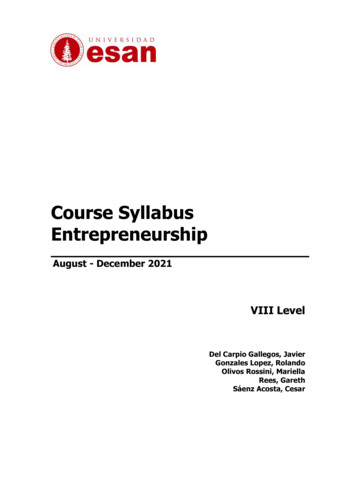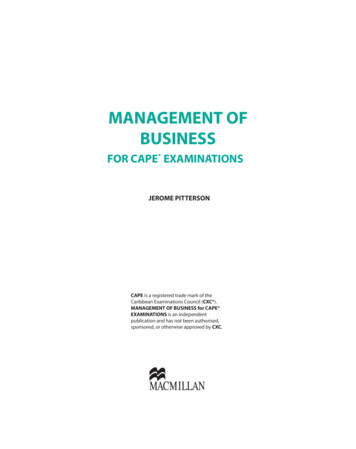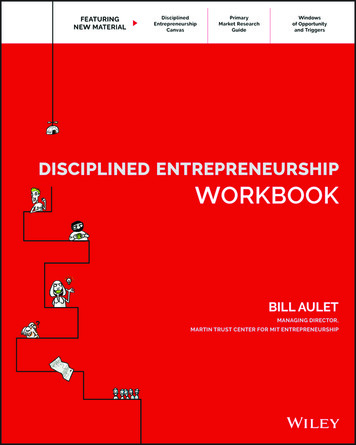
Transcription
Course SyllabusEntrepreneurshipAugust - December 2021VIII LevelDel Carpio Gallegos, JavierGonzales Lopez, RolandoOlivos Rossini, MariellaRees, GarethSáenz Acosta, Cesar
I. General InformationNombre delcurso:EntrepreneurshipRequisito:140 créditos aprobadosCódigo:03356Precedente:No nales:4Modalidad delcurso:Remote SynchronousCarrerasTodas las carrerasCoordinadordel curso:Gareth Reesgrees@esan.edu.peII. SummaryThe course is a mix of theory and practice. The course aims to develop studentknowledge of the entrepreneurial business culture and stages that start-ups go throughat a national or international level. In particular, the course aims to help students: tofirstly, identify and evaluate business opportunities; to secondly, develop the businessidea into a business concept; and to thirdly, exploit a "winning concept" throughunderstanding the business opportunity’s feasibility and growth potential.In addition, the course links individual skills with business competencies and helps thestudent to understand customer needs, to generate business ideas, to identifyopportunities and to gather information to help assess an idea’s viability. Togetherthese aim to enable students to be able to create sustainable and competitivebusinesses for national and international markets.The course is also is designed to help students to understand the meaning ofentrepreneurship and the essential qualities of the entrepreneurial spirit.III. Course objectivesThe objective of the course is to provide the student's with a managed experience ofthe business start-up process. The experience provides students with an understandingof concepts, theories and tools and offers students the opportunity to apply these in apractical way. The course seeks to promote the development of skills necessary forsuccessful opportunity identification, business model conception and identify theircritical elements and to gather data for business feasibility assessment. The coursetherefore asks the student to apply previously learned skills and knowledge, includingcommunication, business analysis, critical thinking, problem solving, decision making,team work and integrate business fundamentals such as accounting, planning,operations, marketing and finance. Students are required to manage their ownperformance within a team environment.IV. Learning ObjectivesAt the end of the course the student will be able to:Identify the importance of entrepreneurship, its different types and thecharacteristics and qualities of entrepreneursCourse Syllabus for “Entrepreneurship”2
Devise, propose, evaluate and defend possible solutions about a specificproblem.Demonstrate written and verbal communication skills in both academic andprofessional assignments.Identify a business’ stakeholders and customers and their roles andresponsibilities.Demonstrate competence to apply basic concepts and principles in differentfields such as business planning and strategy, accounting, economics andfinance, marketing and human resources.Identify and describe the relationships between business functionsRecognize potential investment sources and business growth strategies.V. MethodologyThe methodology of the course emphasizes the active participation of the student, withthe teacher assuming the role of facilitator of learning and as a project coach. Classeswill be generally composed of theory presentation, analysis and discussion of readings,the study and discussion of cases and exercises to be completed in groups.Throughout the course the students will complete individually two (2) theory quizzesbased on set readings and two (2) graded practical’s based on case analysis orpractical research, and, as part of a team, a three-part start-up project, the progress ofwhich will be presented periodically according to the guidelines given in class.Selected chapters from the textbooks are used as the basis of classroom sessions, thereading of which is compulsory and must be completed by the students prior to theteaching session, according to the course schedule.The course will accomplish the learning objectives through a diverse mix of methodsand activities, including:Analysis and evaluation of at least one or more actual cases,Information and workshop sessions conducted by Esan’s FabLab and Innovationhub, InnovaIn-class short case studies and team-based exercises,Working in teams to complete the Start Up project by applying the class andreading materials to identify business ideas, prepare a business model andconduct a feasibility assessment of a selected business idea, andPresentations of the group’s ideas, business model and project feasibility.VI. EvaluationThe evaluation system is permanent and comprehensive, and it is intended to promotestudent learning. The course grade is an average of the permanent evaluation (PEP)(50%), the midterm exam (EP) (25%) and the final exam (EF) (25%)Group and team-based work is important in this course so do not expect to get fullcredit for participation if:You arrive late, leave the class early or simply do not follow the class.Never say a thing in class or when working in your groupDo not actively participate in class activities, group work, ask questions, providefeedback or miss your group’s presentations.Course Syllabus for “Entrepreneurship”3
The following table provides the weights of the permanent evaluation:PERMANENT EVALUATION PONDERATE (PEP) 50%Evaluation TypeDescription%Theory Quiz (2)2 Theory paper quizzes (7.5% each)15%Graded Practical (2)Individual Case Reports or Research Assignment (15% each)30%Class Attendance & ParticipationRegular and punctual attendance. Active participation in groupwork and in class activities10%Part 1 - Elevator Pitch & Concept Brief15%Part 2 - Business Model Canvas15%Part 3 - Feasibility Analysis15%Start Up Team ProjectThe final average (FA) is obtained as follows:FA (0,25 x ME) (0,50 x PEA) (0,25 x FE)FA: Final AverageME: Mid-term ExamPEA: Permanent Evaluation AverageFE: Final ExamVII. Program contentACTIVITIES /EVALUATIONCONTENTWEEKLEARNING UNIT I: INTRODUCTION TO ENTREPRNEUERSHIPLEARNING OUTCOMES:Identify the importance of entrepreneurship, its different types and the characteristics andqualities of entrepreneurs.Presentation of the1 INTRODUCTION TO ENTREPRENEURSHIPCourse Methodology2.1Whatisentrepreneurship1 2.2 Entrepreneurial Characteristics and Qualities23rd toActivity N 12.3 Types of business ventures28thClass Visit: FabLab –AugustInnovation & prototypingMandatory readingBarringer, B. & IrelandEntrepreneurship, pp. 3-36.R.D.Chap.1,IntroductiontospaceLEARNING UNIT 2: START UP IDEAS AND BUSINESS OPPORTUNITIESLEARNING OUTCOMES:Devise, propose, evaluate and defend possible solutions about a specific problem.Demonstrate written and verbal communication skills in both academic and professionalassignments.2 2STARTUPOPPORTUNITIESIDEASANDBUSINESS30th2.1 Forming a new venture teamAugust to 2.2 Generating Ideas and recognizing business4thopportunitiesSeptember Mandatory readingBarringer, B. & Ireland R.D. Chap. 9, Building a New-VentureTeam, pp. 285-312Barringer, B. & Ireland R.D. Chap. 2, Recognizing Opportunitiesand Generating Ideas, pp. 40-72.Course Syllabus for “Entrepreneurship”Start-Up project Part 1set:Business idea Pitch andConcept statement.4
3 6th to 11SeptemberTheory Quiz #1:Quiz on Mi Tiendicita deModa reading and BarringerChapts 1 & 2 andOsterwalder Chapt 32.3 Generating Ideas2.4 Pitching IdeasMandatory readingOsterwalder, A. & Pigneur, Y. Part 3 - Design, pp. 122-195Activity N 2&3Class Visit: Innova –Generating IdeasClass Visit: Innova –Developing PitchesLEARNING UNIT 3: BUSINESS MODELSLEARNING OUTCOMES:Propose, evaluate and defend possible solutions about a specific problem.Identify business stakeholders and customers and their roles and responsibilities.Identify and describe the relationships between business functions.Demonstrate written and verbal communication skills in both academic and professionalassignments.3 BUSINESS MODELS4 3.13.2Introduction to business modelsDeveloping effective business modelsStudent Presentation Idea Pitches 2nd session of13th toweek18thSeptember Mandatory readingStart-Up project Part 1DueBusiness idea Pitch andConcept statement.Barringer, B. & Ireland R.D. Chap. 6, Developing an EffectiveBusiness Model, pp. 177-205.Osterwalder& Pigneur, Y., Part 2 - Patterns, pp. 51-1215 3.3The Business Model CANVAS20th to3.4Value Proposition & Customer Segments25thMandatory readingSeptemberStart-up Project Part 2set: - Business ModelCANVASOsterwalder, A. & Pigneur, Y. Part 1 - Intro, pp. 1-513.53.6Channels and Customer RelationshipsRevenues6 27thSeptemberto 2ndOctober7 4th to 9thOctober3.73.8Key Resources, Key ActivitiesKey Partners &Cost StructureMandatory readingOste Osterwalder, A. & Pigneur, Y. Part 1 - Intro, pp. 1-518 11th to16thOctoberCourse Syllabus for “Entrepreneurship”Activity N 4Session 1 Short 3-4 slidepresentation - ValueProposition & CustomerSegment componentsTheory Quiz #2:Quiz on Business ModelInnovation reading,Barringer Chapt 6 andOsterwalder parts 1&2Activity N 5Session 1 Short 3-4 slidepresentation - Channels,Relationships &/or RevenueMIDTERM EXAM5
LEARNING UNIT 4: BUSINESS IDEA FEASIBILITYLEARNING OUTCOMES:Identify business’ stakeholders and customers and their roles and responsibilities.Demonstrate competence of basic concepts and principles in different fields such asbusiness planning and strategy, accounting, economics and finance, marketing and humanresources.Identify and describe the relationships between business functions.Demonstrate written and verbal communication skills.9 18th to23rdOctober4.14.2Mandatory readingBarringer, B. & Ireland R.D. Chap 3, Feasibility Analysis, pp. 77109Barringer, B. & Ireland R.D. Chap 7, Preparing the proper ethicaland legal foundation, (only these pages) pp. 211-21810 25th to30thOctober11 1st to 6thNovemberBusiness feasibilityStart–up Ethics and Managing StakeholdersBUSINESS MODEL CANVAS PRESENTATIONS4.34.4Product / Service FeasibilityIndustry and Competitor AnalysisMandatory readingBarringer, B. & Ireland R.D. Chap. 5, Industry and CompetitorAnalysis, pp. 145-175.12 8th to13thNovember4.513 15th to20thNovember4.64.7Start Up Project Part 2due: Hand-in / upload yourgroup’s written CanvasReportStart Up Project Part 3set: - Feasibility StudyGraded Practical #1 Set:Research project or CaseanalysisStart Up Project Part 2due: Group Presentationsof your CANVAS MODELInd Assign #1 due:Hand in / upload yourResearch or Case reportGraded Practical #2 Set:Research project or CaseanalysisAssessing a new venture s financial strength andviabilityMandatory readingBarringer, B. & Ireland R.D. Chap. 8, Assessing a New Venture’sFinancial Strength and Viability pp. 249-283Organizational feasibilityNon-Financial resourcesMandatory readingBarringer, B. & Ireland R.D. Chap. 9, Building a New-VentureTeam, pp. 285-312Ind Assign #2 due:Hand in / upload yourResearch or Case reportLEARNING UNIT 5: START UP FINANCING AND GROWTHLEARNING OUTCOMES:Identify and describe business function interrelationships.Formulate and evaluate investments.14 22nd to27thNovember15 29thNovember5.15.25.3Getting Financing and FundingPreparing and evaluating the challenges of growthStrategies of firm growthMandatory readingBarringer, B. & Ireland R.D. Chap. 10, Getting Financing orFunding, pp. 316-350Barringer, B. & Ireland R.D. Chapter 13 Preparing andevaluating the challenges of growth pp. 425-453Barringer, B. & Ireland R.D. Chapter 14 Strategies for FirmGrowth, pp. 454-485FINAL PITCH PRESENTATIONSCourse Syllabus for “Entrepreneurship”Start Up Project Part 3due:Hand in / Upload yourgroup’s written feasibilityreportStart Up Project Part 3due: Final PitchPresentations6
to 4thDecember16 6th to11thDecemberFINAL EXAMVIII. ReferencesTextbook (Selected Chapters)Barringer, B. & Ireland D., (2012). Entrepreneurship: Successfully LaunchingNew Ventures, 4th Edition. Pearson, New YorkOsterwalder, A. & Pigneur, Y. (2010). Business Model Generation. John Wileyand Son, New Jersey.Theory papersTietz, M. & Calderón Urbina, S. (2015). Mi Tiendecita de moda: Selling fashionthrough facebook in Peru. Ivey Cases, W15311, pp.1-11Trimi, S & Berbegal-Mirabent, J. (2012) Business model innovation inentrepreneurship. International Entrepreneurship Management Journal, 8,pp.449-465Cases for Graded Practical’sWesley, D & Puffer, S. (2012). Mining and Corporate Social Responsibility: BHPBilliton and the Tinaya dialogue. Ivey Cases, W12764, pp. 1-9Grossman, E., & Grossman, D., (2017). John Q. Inventor and the cardboardsnowplow. USC Marshall Cases, SCG-531, pp. 1-4.Integrated Case – ParlerAdditional Readings or Graded Practical cases may be assigned from time to time.IX Lab SupportNot necessaryX. ProfessorsDel Carpio Gallegos Javierjdelcarpio@esan.edu.peRees Garethgrees@esan.edu.peGonzales Lopez Rolandorgonzales@esan.edu.peCourse Syllabus for “Entrepreneurship”Olivos Rossini Mariellamolivos@esan.edu.peSáenz Acosta Cesarcsaenz@esan.edu.pe7
Course Syllabus for "Entrepreneurship" 7 to 4th December 16 6th to 11th December FINAL EXAM VIII. References Textbook (Selected Chapters) Barringer, B. & Ireland D., (2012). Entrepreneurship: Successfully Launching New Ventures, 4th Edition. Pearson, New York Osterwalder, A. & Pigneur, Y. (2010). Business Model Generation. John Wiley










